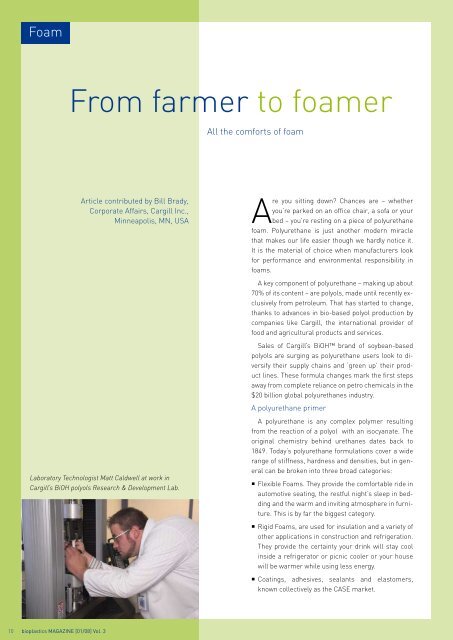01 | 2008
You also want an ePaper? Increase the reach of your titles
YUMPU automatically turns print PDFs into web optimized ePapers that Google loves.
Foam<br />
From farmer to foamer<br />
All the comforts of foam<br />
Article contributed by Bill Brady,<br />
Corporate Affairs, Cargill Inc.,<br />
Minneapolis, MN, USA<br />
Laboratory Technologist Matt Caldwell at work in<br />
Cargill‘s BiOH polyols Research & Development Lab.<br />
Are you sitting down? Chances are – whether<br />
you’re parked on an office chair, a sofa or your<br />
bed – you’re resting on a piece of polyurethane<br />
foam. Polyurethane is just another modern miracle<br />
that makes our life easier though we hardly notice it.<br />
It is the material of choice when manufacturers look<br />
for performance and environmental responsibility in<br />
foams.<br />
A key component of polyurethane – making up about<br />
70% of its content – are polyols, made until recently exclusively<br />
from petroleum. That has started to change,<br />
thanks to advances in bio-based polyol production by<br />
companies like Cargill, the international provider of<br />
food and agricultural products and services.<br />
Sales of Cargill’s BiOH brand of soybean-based<br />
polyols are surging as polyurethane users look to diversify<br />
their supply chains and ‘green up’ their product<br />
lines. These formula changes mark the first steps<br />
away from complete reliance on petro chemicals in the<br />
$20 billion global polyurethanes industry.<br />
A polyurethane primer<br />
A polyurethane is any complex polymer resulting<br />
from the reaction of a polyol with an isocyanate. The<br />
original chemistry behind urethanes dates back to<br />
1849. Today’s polyurethane formulations cover a wide<br />
range of stiffness, hardness and densities, but in general<br />
can be broken into three broad categories:<br />
• Flexible Foams. They provide the comfortable ride in<br />
automotive seating, the restful night’s sleep in bedding<br />
and the warm and inviting atmosphere in furniture.<br />
This is by far the biggest category.<br />
• Rigid Foams, are used for insulation and a variety of<br />
other applications in construction and refrigeration.<br />
They provide the certainty your drink will stay cool<br />
inside a refrigerator or picnic cooler or your house<br />
will be warmer while using less energy.<br />
• Coatings, adhesives, sealants and elastomers,<br />
known collectively as the CASE market.<br />
10 bioplastics MAGAZINE [<strong>01</strong>/08] Vol. 3


















